ECU MAZDA MODEL 3 HATCHBACK 2005 Owner's Manual (in English)
[x] Cancel search | Manufacturer: MAZDA, Model Year: 2005, Model line: MODEL 3 HATCHBACK, Model: MAZDA MODEL 3 HATCHBACK 2005Pages: 322, PDF Size: 4.7 MB
Page 16 of 322
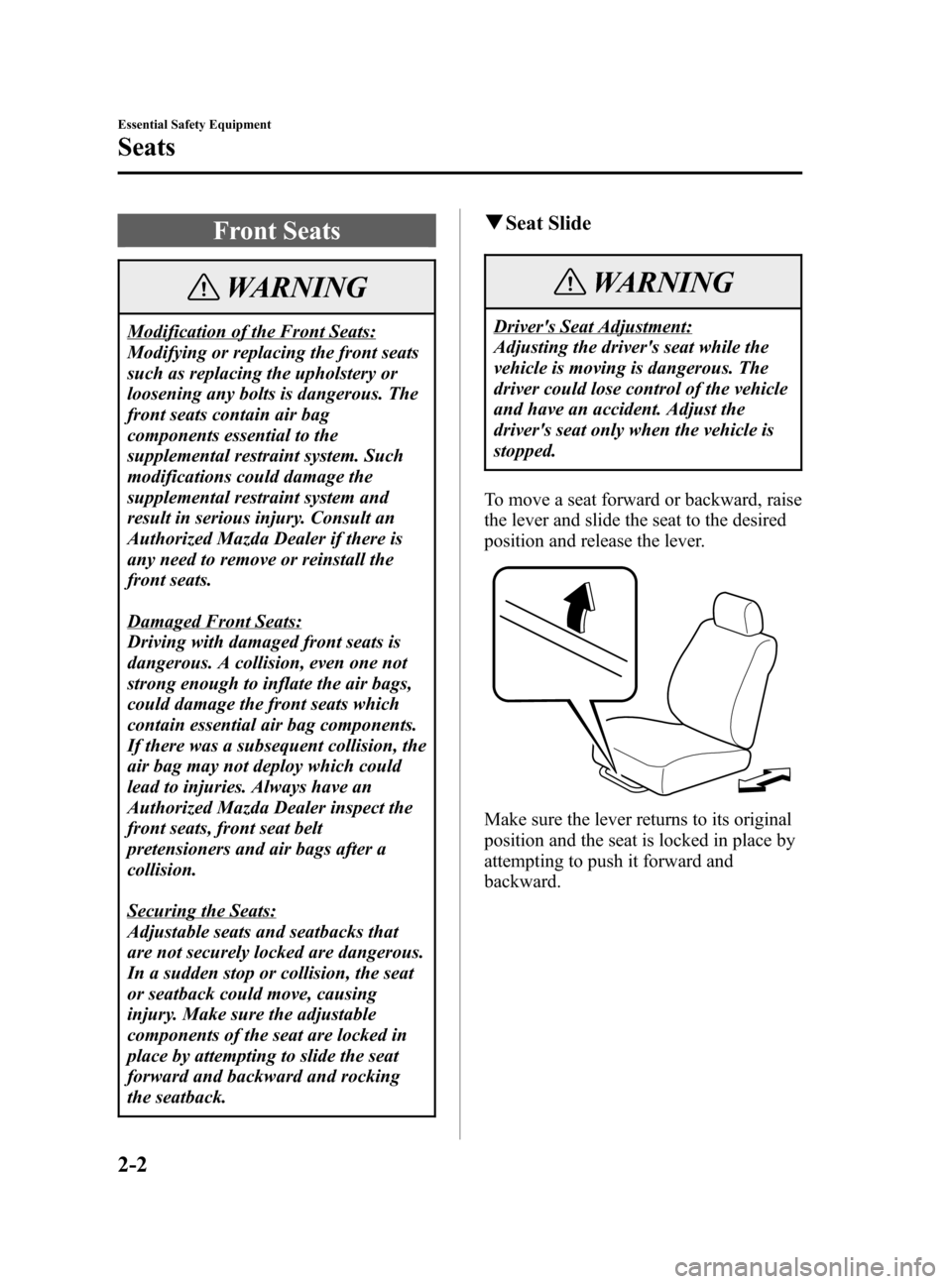
Black plate (16,1)
Front Seats
WARNING
Modification of the Front Seats:
Modifying or replacing the front seats
such as replacing the upholstery or
loosening any bolts is dangerous. The
front seats contain air bag
components essential to the
supplemental restraint system. Such
modifications could damage the
supplemental restraint system and
result in serious injury. Consult an
Authorized Mazda Dealer if there is
any need to remove or reinstall the
front seats.
Damaged Front Seats:
Driving with damaged front seats is
dangerous. A collision, even one not
strong enough to inflate the air bags,
could damage the front seats which
contain essential air bag components.
If there was a subsequent collision, the
air bag may not deploy which could
lead to injuries. Always have an
Authorized Mazda Dealer inspect the
front seats, front seat belt
pretensioners and air bags after a
collision.
Securing the Seats:
Adjustable seats and seatbacks that
are not securely locked are dangerous.
In a sudden stop or collision, the seat
or seatback could move, causing
injury. Make sure the adjustable
components of the seat are locked in
place by attempting to slide the seat
forward and backward and rocking
the seatback.
qSeat Slide
WARNING
Driver's Seat Adjustment:
Adjusting the driver's seat while the
vehicle is moving is dangerous. The
driver could lose control of the vehicle
and have an accident. Adjust the
driver's seat only when the vehicle is
stopped.
To move a seat forward or backward, raise
the lever and slide the seat to the desired
position and release the lever.
Make sure the lever returns to its original
position and the seat is locked in place by
attempting to push it forward and
backward.
2-2
Essential Safety Equipment
Seats
Mazda3_8T97-EC-04J_Edition1 Page16
Saturday, September 25 2004 2:6 PM
Form No.8T97-EC-04J
Page 19 of 322
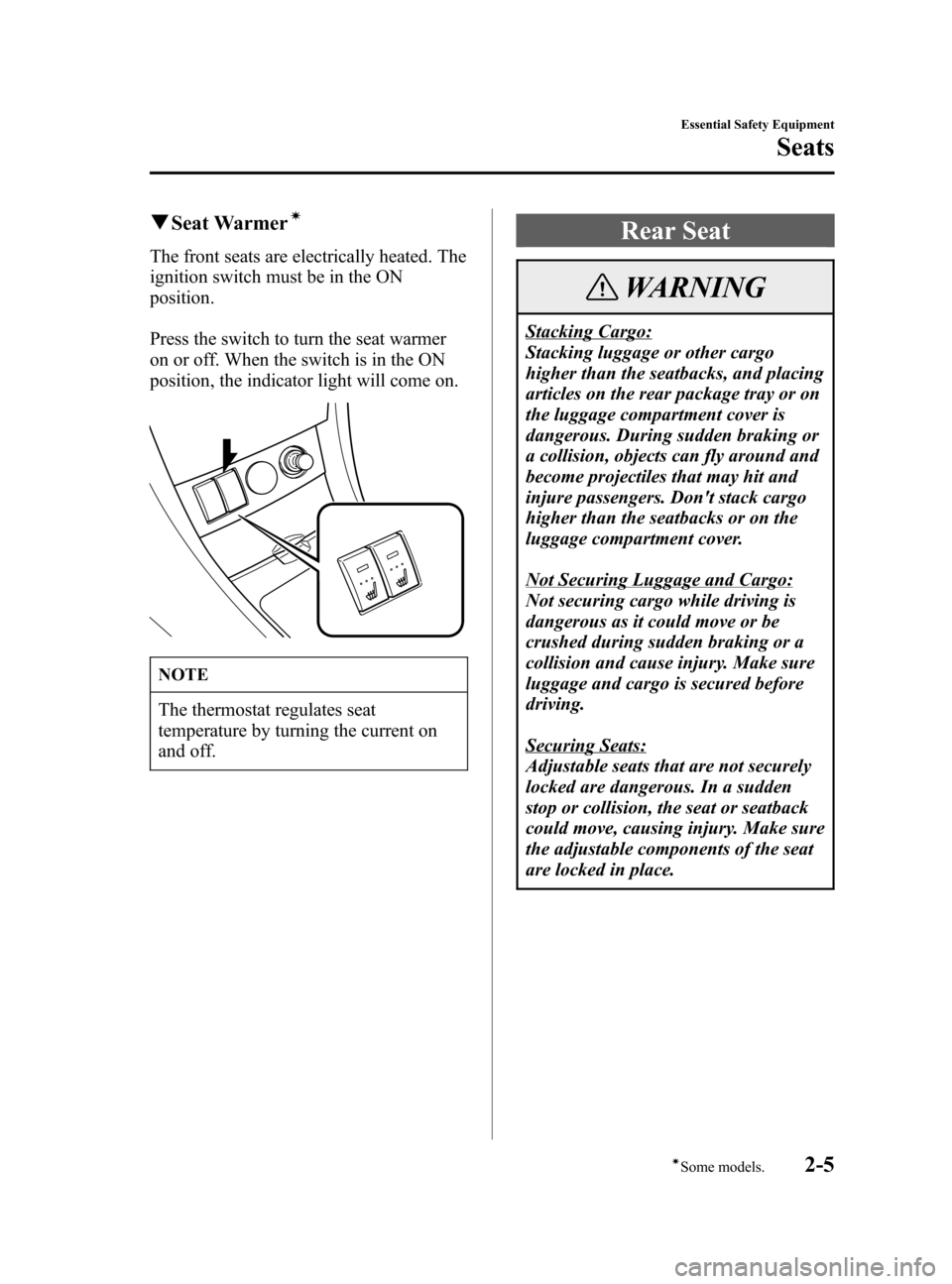
Black plate (19,1)
qSeat Warmerí
The front seats are electrically heated. The
ignition switch must be in the ON
position.
Press the switch to turn the seat warmer
on or off. When the switch is in the ON
position, the indicator light will come on.
NOTE
The thermostat regulates seat
temperature by turning the current on
and off.
Rear Seat
WARNING
Stacking Cargo:
Stacking luggage or other cargo
higher than the seatbacks, and placing
articles on the rear package tray or on
the luggage compartment cover is
dangerous. During sudden braking or
a collision, objects can fly around and
become projectiles that may hit and
injure passengers. Don't stack cargo
higher than the seatbacks or on the
luggage compartment cover.
Not Securing Luggage and Cargo:
Not securing cargo while driving is
dangerous as it could move or be
crushed during sudden braking or a
collision and cause injury. Make sure
luggage and cargo is secured before
driving.
Securing Seats:
Adjustable seats that are not securely
locked are dangerous. In a sudden
stop or collision, the seat or seatback
could move, causing injury. Make sure
the adjustable components of the seat
are locked in place.
Essential Safety Equipment
Seats
2-5íSome models. Mazda3_8T97-EC-04J_Edition1 Page19
Saturday, September 25 2004 2:6 PM
Form No.8T97-EC-04J
Page 22 of 322
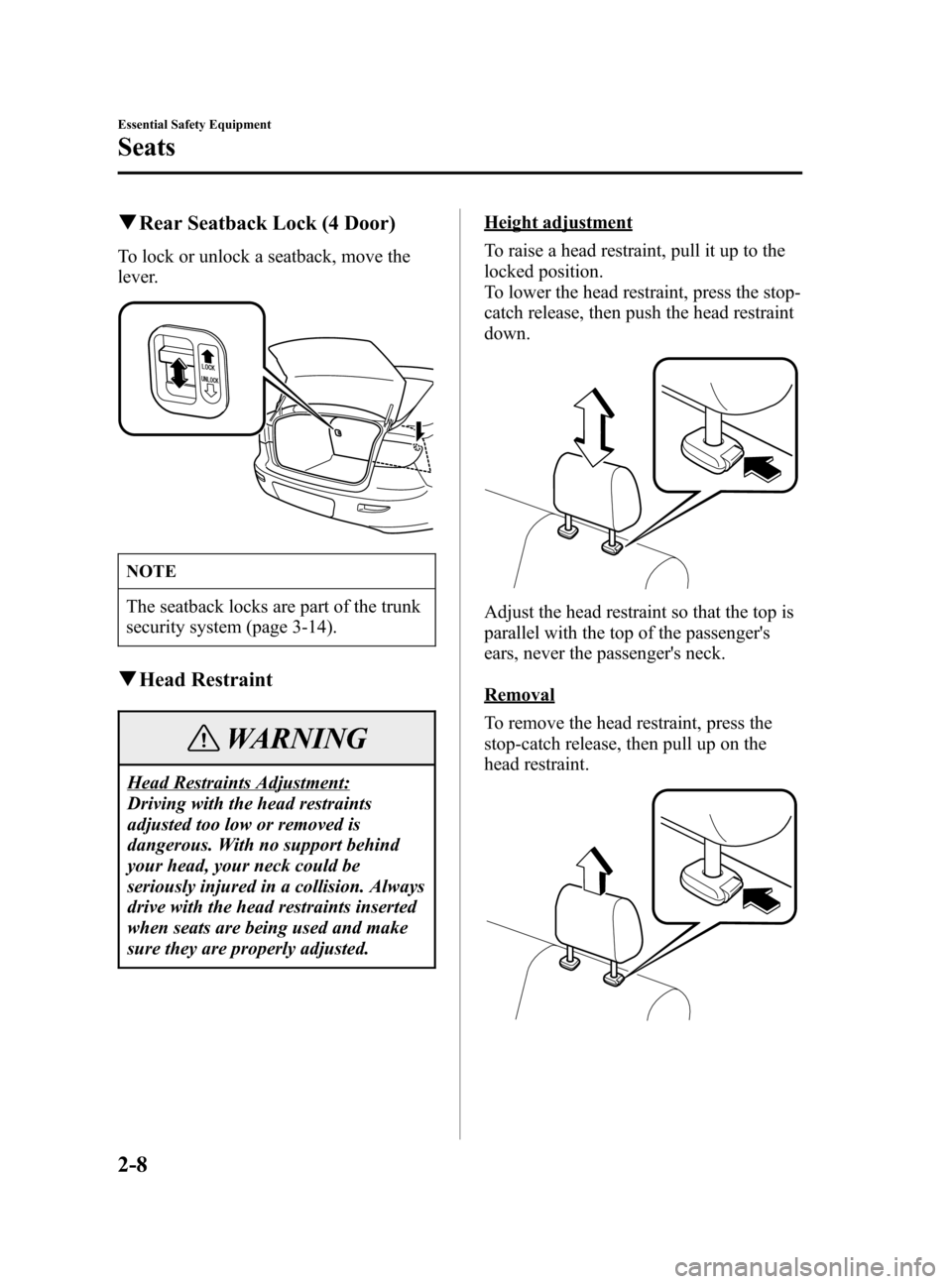
Black plate (22,1)
qRear Seatback Lock (4 Door)
To lock or unlock a seatback, move the
lever.
NOTE
The seatback locks are part of the trunk
security system (page 3-14).
qHead Restraint
WARNING
Head Restraints Adjustment:
Driving with the head restraints
adjusted too low or removed is
dangerous. With no support behind
your head, your neck could be
seriously injured in a collision. Always
drive with the head restraints inserted
when seats are being used and make
sure they are properly adjusted.
Height adjustment
To raise a head restraint, pull it up to the
locked position.
To lower the head restraint, press the stop-
catch release, then push the head restraint
down.
Adjust the head restraint so that the top is
parallel with the top of the passenger's
ears, never the passenger's neck.
Removal
To remove the head restraint, press the
stop-catch release, then pull up on the
head restraint.
2-8
Essential Safety Equipment
Seats
Mazda3_8T97-EC-04J_Edition1 Page22
Saturday, September 25 2004 2:7 PM
Form No.8T97-EC-04J
Page 23 of 322
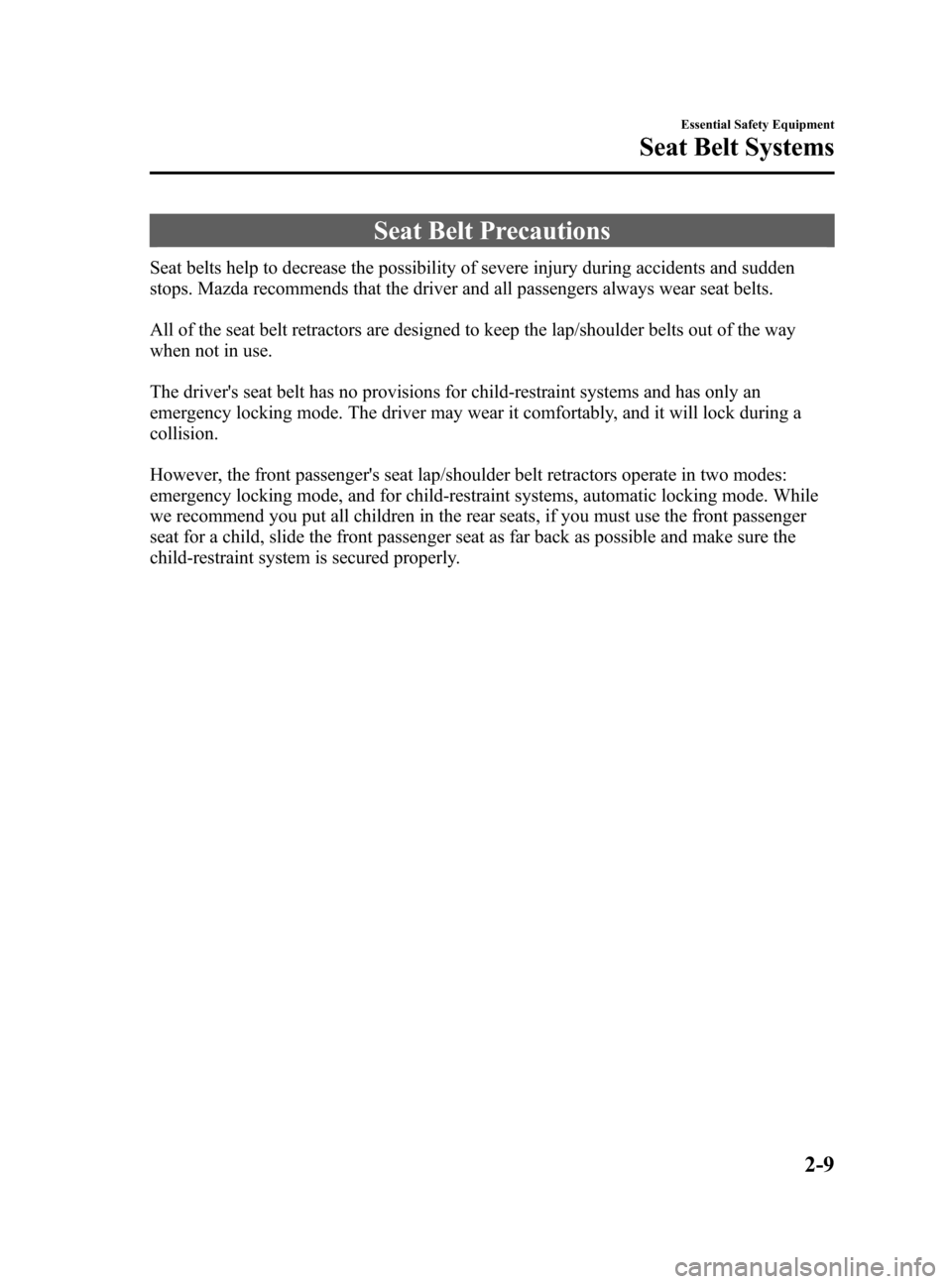
Black plate (23,1)
Seat Belt Precautions
Seat belts help to decrease the possibility of severe injury during accidents and sudden
stops. Mazda recommends that the driver and all passengers always wear seat belts.
All of the seat belt retractors are designed to keep the lap/shoulder belts out of the way
when not in use.
The driver's seat belt has no provisions for child-restraint systems and has only an
emergency locking mode. The driver may wear it comfortably, and it will lock during a
collision.
However, the front passenger's seat lap/shoulder belt retractors operate in two modes:
emergency locking mode, and for child-restraint systems, automatic locking mode. While
we recommend you put all children in the rear seats, if you must use the front passenger
seat for a child, slide the front passenger seat as far back as possible and make sure the
child-restraint system is secured properly.
Essential Safety Equipment
Seat Belt Systems
2-9
Mazda3_8T97-EC-04J_Edition1 Page23
Saturday, September 25 2004 2:7 PM
Form No.8T97-EC-04J
Page 32 of 322
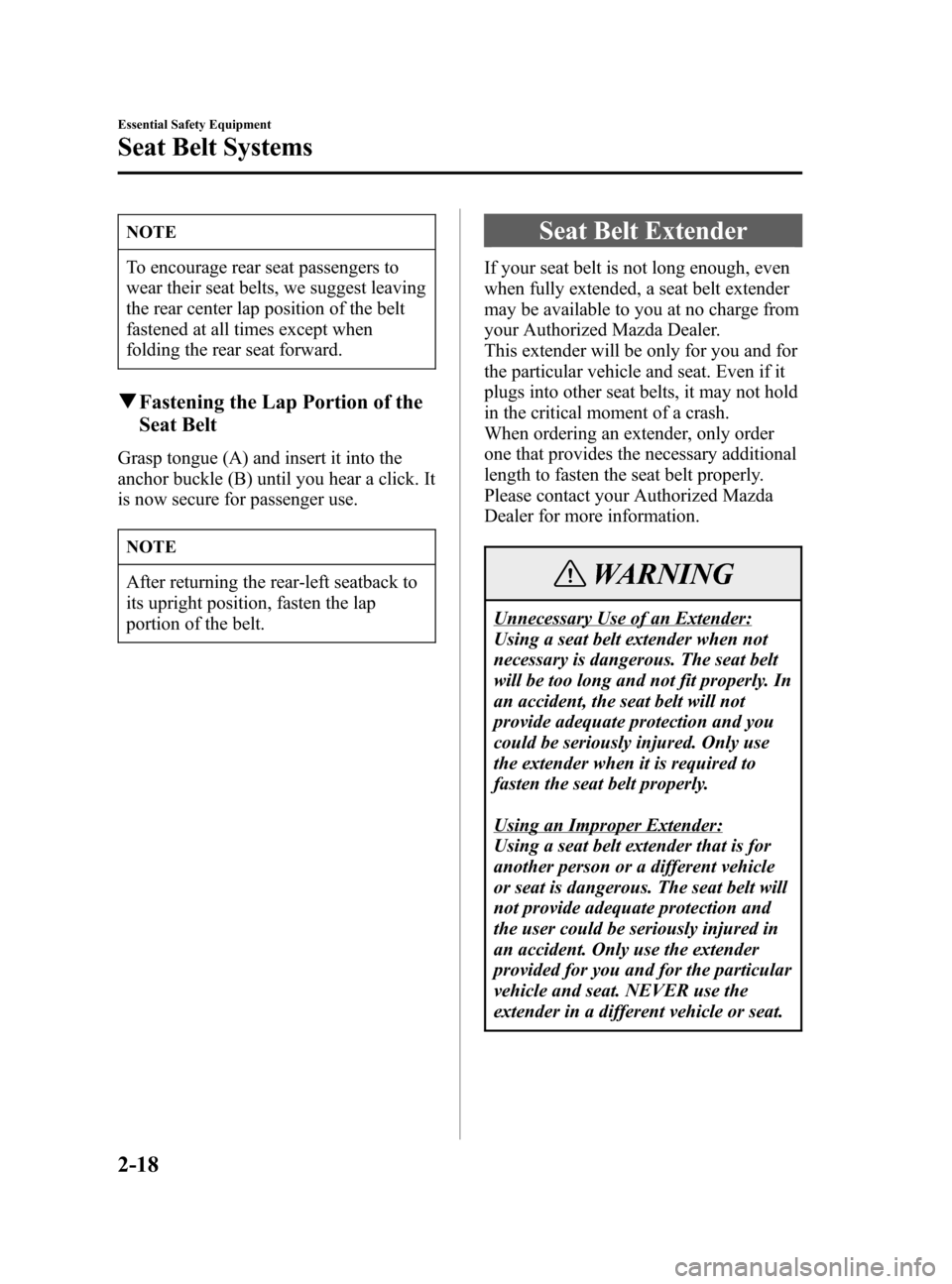
Black plate (32,1)
NOTE
To encourage rear seat passengers to
wear their seat belts, we suggest leaving
the rear center lap position of the belt
fastened at all times except when
folding the rear seat forward.
qFastening the Lap Portion of the
Seat Belt
Grasp tongue (A) and insert it into the
anchor buckle (B) until you hear a click. It
is now secure for passenger use.
NOTE
After returning the rear-left seatback to
its upright position, fasten the lap
portion of the belt.
Seat Belt Extender
If your seat belt is not long enough, even
when fully extended, a seat belt extender
may be available to you at no charge from
your Authorized Mazda Dealer.
This extender will be only for you and for
the particular vehicle and seat. Even if it
plugs into other seat belts, it may not hold
in the critical moment of a crash.
When ordering an extender, only order
one that provides the necessary additional
length to fasten the seat belt properly.
Please contact your Authorized Mazda
Dealer for more information.
WARNING
Unnecessary Use of an Extender:
Using a seat belt extender when not
necessary is dangerous. The seat belt
will be too long and not fit properly. In
an accident, the seat belt will not
provide adequate protection and you
could be seriously injured. Only use
the extender when it is required to
fasten the seat belt properly.
Using an Improper Extender:
Using a seat belt extender that is for
another person or a different vehicle
or seat is dangerous. The seat belt will
not provide adequate protection and
the user could be seriously injured in
an accident. Only use the extender
provided for you and for the particular
vehicle and seat. NEVER use the
extender in a different vehicle or seat.
2-18
Essential Safety Equipment
Seat Belt Systems
Mazda3_8T97-EC-04J_Edition1 Page32
Saturday, September 25 2004 2:7 PM
Form No.8T97-EC-04J
Page 35 of 322
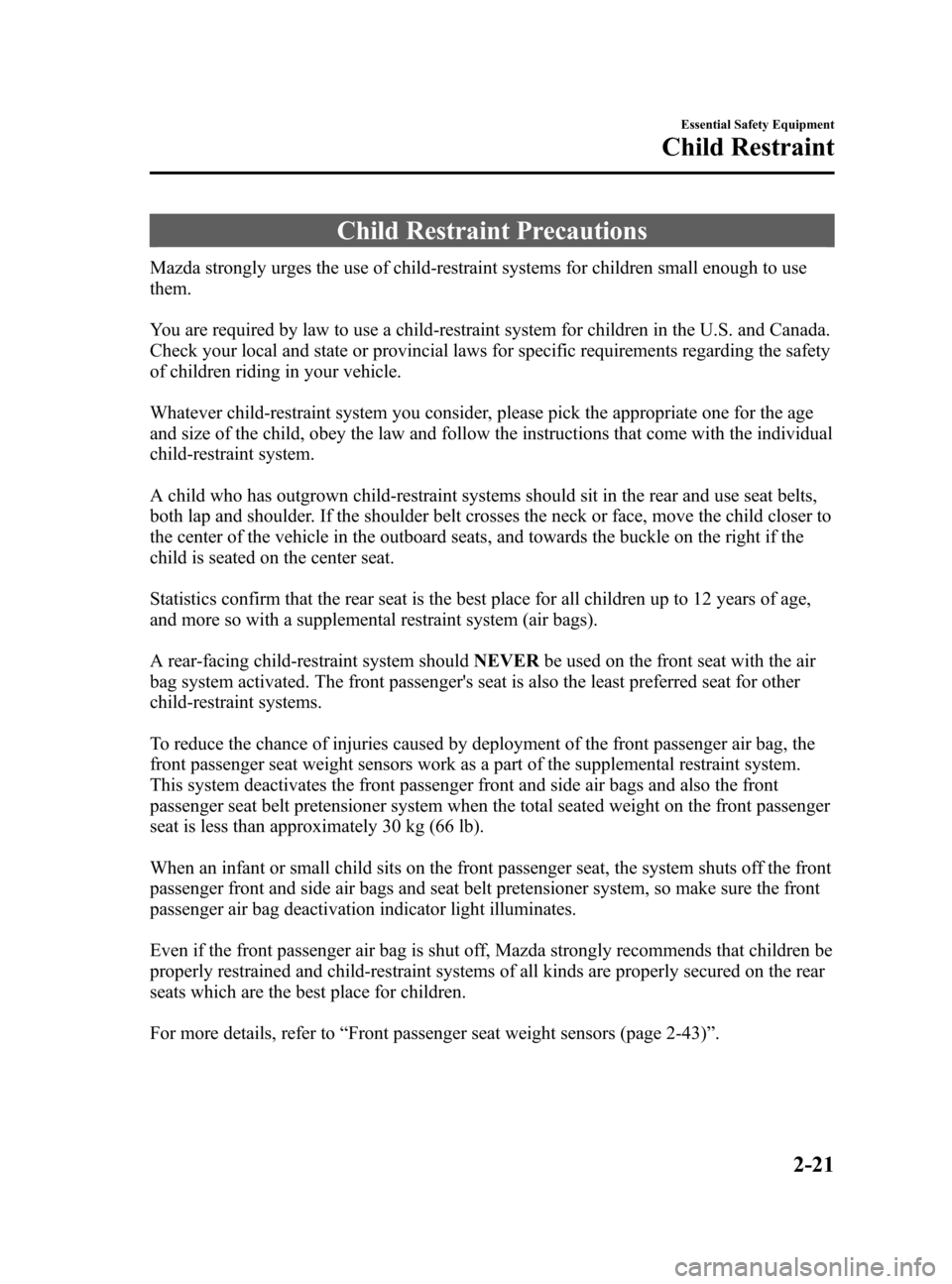
Black plate (35,1)
Child Restraint Precautions
Mazda strongly urges the use of child-restraint systems for children small enough to use
them.
You are required by law to use a child-restraint system for children in the U.S. and Canada.
Check your local and state or provincial laws for specific requirements regarding the safety
of children riding in your vehicle.
Whatever child-restraint system you consider, please pick the appropriate one for the age
and size of the child, obey the law and follow the instructions that come with the individual
child-restraint system.
A child who has outgrown child-restraint systems should sit in the rear and use seat belts,
both lap and shoulder. If the shoulder belt crosses the neck or face, move the child closer to
the center of the vehicle in the outboard seats, and towards the buckle on the right if the
child is seated on the center seat.
Statistics confirm that the rear seat is the best place for all children up to 12 years of age,
and more so with a supplemental restraint system (air bags).
A rear-facing child-restraint system shouldNEVERbe used on the front seat with the air
bag system activated. The front passenger's seat is also the least preferred seat for other
child-restraint systems.
To reduce the chance of injuries caused by deployment of the front passenger air bag, the
front passenger seat weight sensors work as a part of the supplemental restraint system.
This system deactivates the front passenger front and side air bags and also the front
passenger seat belt pretensioner system when the total seated weight on the front passenger
seat is less than approximately 30 kg (66 lb).
When an infant or small child sits on the front passenger seat, the system shuts off the front
passenger front and side air bags and seat belt pretensioner system, so make sure the front
passenger air bag deactivation indicator light illuminates.
Even if the front passenger air bag is shut off, Mazda strongly recommends that children be
properly restrained and child-restraint systems of all kinds are properly secured on the rear
seats which are the best place for children.
For more details, refer to“Front passenger seat weight sensors (page 2-43)”.
Essential Safety Equipment
Child Restraint
2-21
Mazda3_8T97-EC-04J_Edition1 Page35
Saturday, September 25 2004 2:7 PM
Form No.8T97-EC-04J
Page 36 of 322
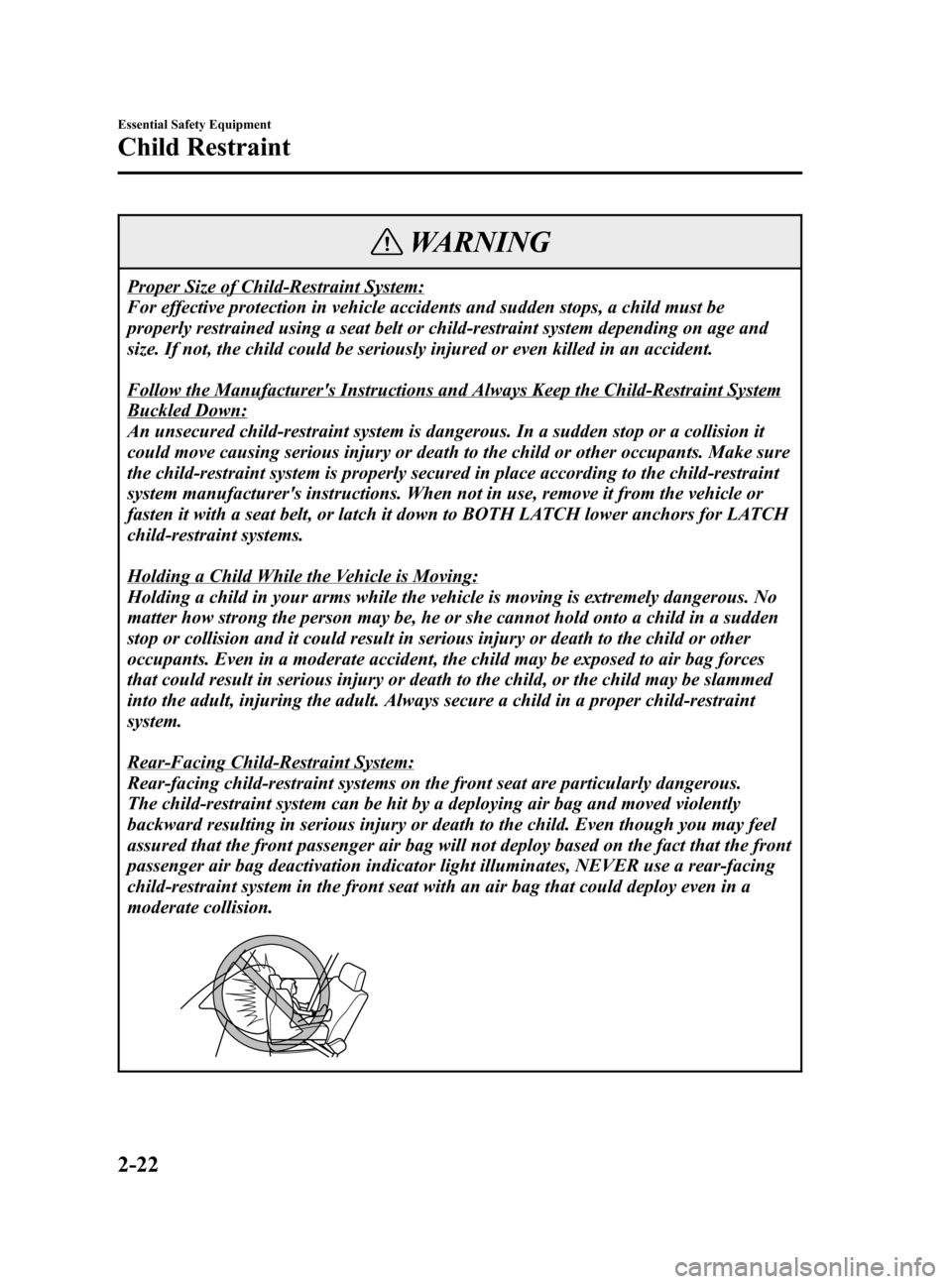
Black plate (36,1)
WARNING
Proper Size of Child-Restraint System:
For effective protection in vehicle accidents and sudden stops, a child must be
properly restrained using a seat belt or child-restraint system depending on age and
size. If not, the child could be seriously injured or even killed in an accident.
Follow the Manufacturer's Instructions and Always Keep the Child-Restraint System
Buckled Down:
An unsecured child-restraint system is dangerous. In a sudden stop or a collision it
could move causing serious injury or death to the child or other occupants. Make sure
the child-restraint system is properly secured in place according to the child-restraint
system manufacturer's instructions. When not in use, remove it from the vehicle or
fasten it with a seat belt, or latch it down to BOTH LATCH lower anchors for LATCH
child-restraint systems.
Holding a Child While the Vehicle is Moving:
Holding a child in your arms while the vehicle is moving is extremely dangerous. No
matter how strong the person may be, he or she cannot hold onto a child in a sudden
stop or collision and it could result in serious injury or death to the child or other
occupants. Even in a moderate accident, the child may be exposed to air bag forces
that could result in serious injury or death to the child, or the child may be slammed
into the adult, injuring the adult. Always secure a child in a proper child-restraint
system.
Rear-Facing Child-Restraint System:
Rear-facing child-restraint systems on the front seat are particularly dangerous.
The child-restraint system can be hit by a deploying air bag and moved violently
backward resulting in serious injury or death to the child. Even though you may feel
assured that the front passenger air bag will not deploy based on the fact that the front
passenger air bag deactivation indicator light illuminates, NEVER use a rear-facing
child-restraint system in the front seat with an air bag that could deploy even in a
moderate collision.
2-22
Essential Safety Equipment
Child Restraint
Mazda3_8T97-EC-04J_Edition1 Page36
Saturday, September 25 2004 2:7 PM
Form No.8T97-EC-04J
Page 38 of 322
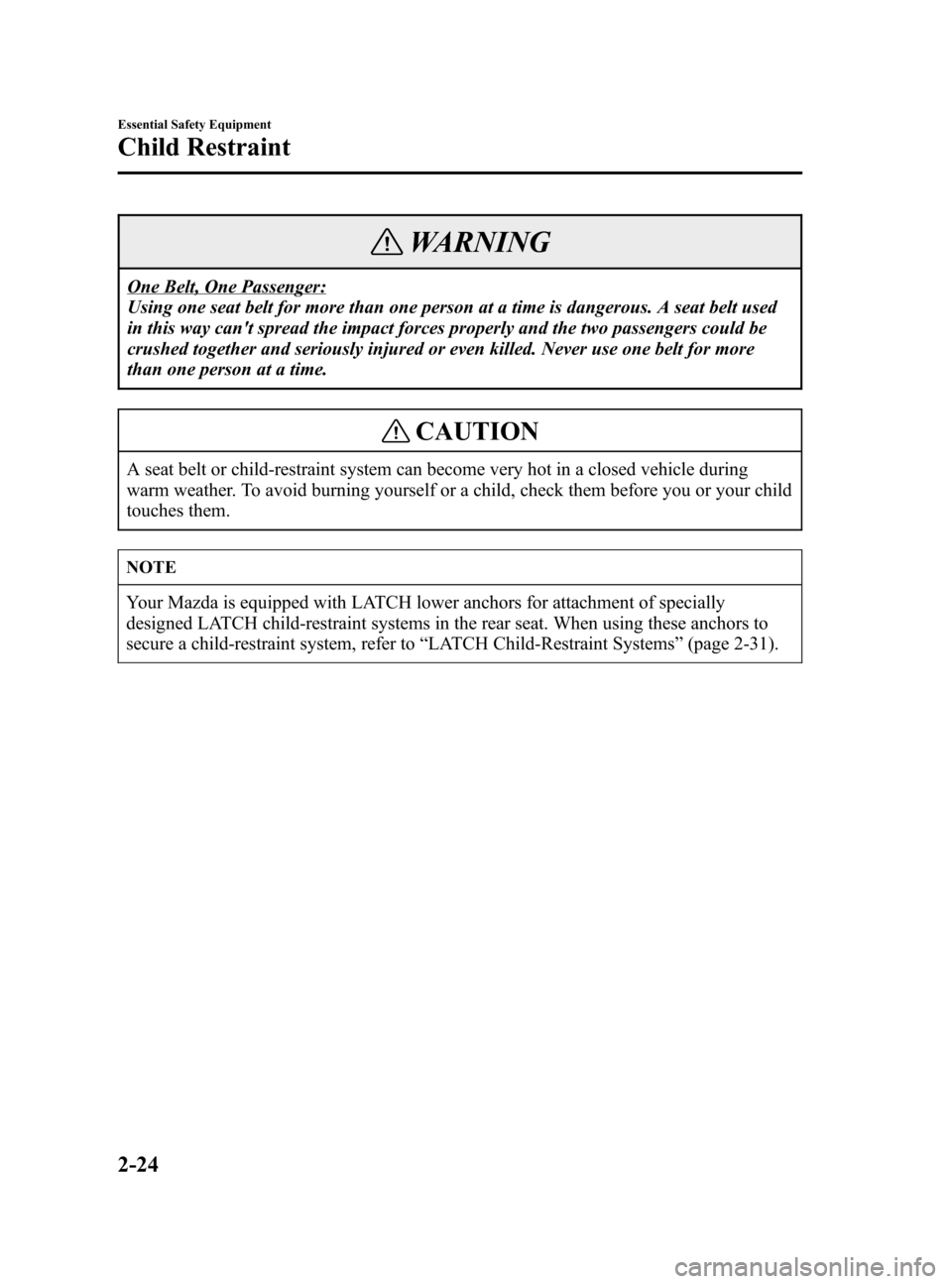
Black plate (38,1)
WARNING
One Belt, One Passenger:
Using one seat belt for more than one person at a time is dangerous. A seat belt used
in this way can't spread the impact forces properly and the two passengers could be
crushed together and seriously injured or even killed. Never use one belt for more
than one person at a time.
CAUTION
A seat belt or child-restraint system can become very hot in a closed vehicle during
warm weather. To avoid burning yourself or a child, check them before you or your child
touches them.
NOTE
Your Mazda is equipped with LATCH lower anchors for attachment of specially
designed LATCH child-restraint systems in the rear seat. When using these anchors to
secure a child-restraint system, refer to“LATCH Child-Restraint Systems”(page 2-31).
2-24
Essential Safety Equipment
Child Restraint
Mazda3_8T97-EC-04J_Edition1 Page38
Saturday, September 25 2004 2:7 PM
Form No.8T97-EC-04J
Page 39 of 322
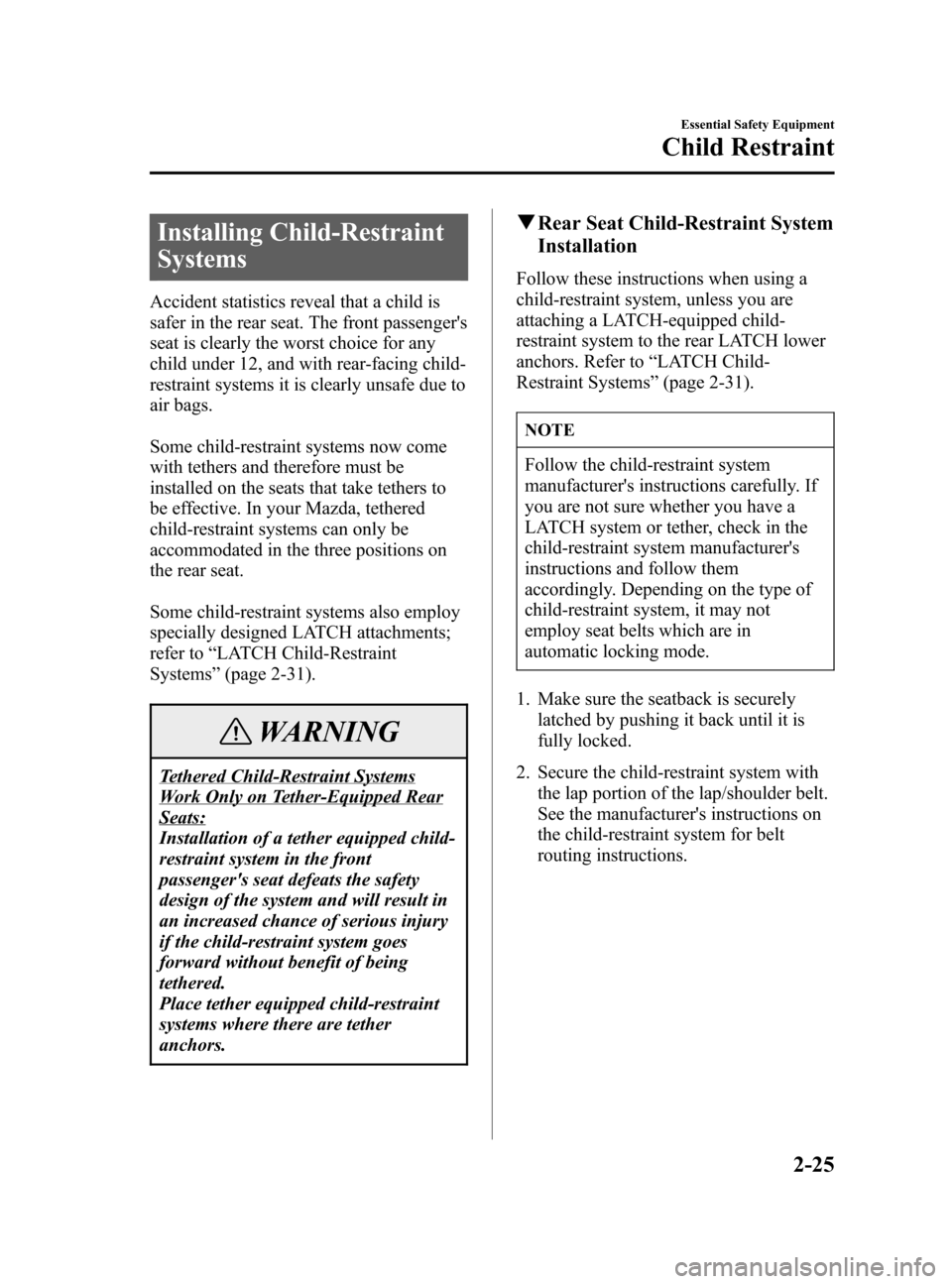
Black plate (39,1)
Installing Child-Restraint
Systems
Accident statistics reveal that a child is
safer in the rear seat. The front passenger's
seat is clearly the worst choice for any
child under 12, and with rear-facing child-
restraint systems it is clearly unsafe due to
air bags.
Some child-restraint systems now come
with tethers and therefore must be
installed on the seats that take tethers to
be effective. In your Mazda, tethered
child-restraint systems can only be
accommodated in the three positions on
the rear seat.
Some child-restraint systems also employ
specially designed LATCH attachments;
refer to“LATCH Child-Restraint
Systems”(page 2-31).
WARNING
Tethered Child-Restraint Systems
Work Only on Tether-Equipped Rear
Seats:
Installation of a tether equipped child-
restraint system in the front
passenger's seat defeats the safety
design of the system and will result in
an increased chance of serious injury
if the child-restraint system goes
forward without benefit of being
tethered.
Place tether equipped child-restraint
systems where there are tether
anchors.
qRear Seat Child-Restraint System
Installation
Follow these instructions when using a
child-restraint system, unless you are
attaching a LATCH-equipped child-
restraint system to the rear LATCH lower
anchors. Refer to“LATCH Child-
Restraint Systems”(page 2-31).
NOTE
Follow the child-restraint system
manufacturer's instructions carefully. If
you are not sure whether you have a
LATCH system or tether, check in the
child-restraint system manufacturer's
instructions and follow them
accordingly. Depending on the type of
child-restraint system, it may not
employ seat belts which are in
automatic locking mode.
1. Make sure the seatback is securely
latched by pushing it back until it is
fully locked.
2. Secure the child-restraint system with
the lap portion of the lap/shoulder belt.
See the manufacturer's instructions on
the child-restraint system for belt
routing instructions.
Essential Safety Equipment
Child Restraint
2-25
Mazda3_8T97-EC-04J_Edition1 Page39
Saturday, September 25 2004 2:7 PM
Form No.8T97-EC-04J
Page 41 of 322
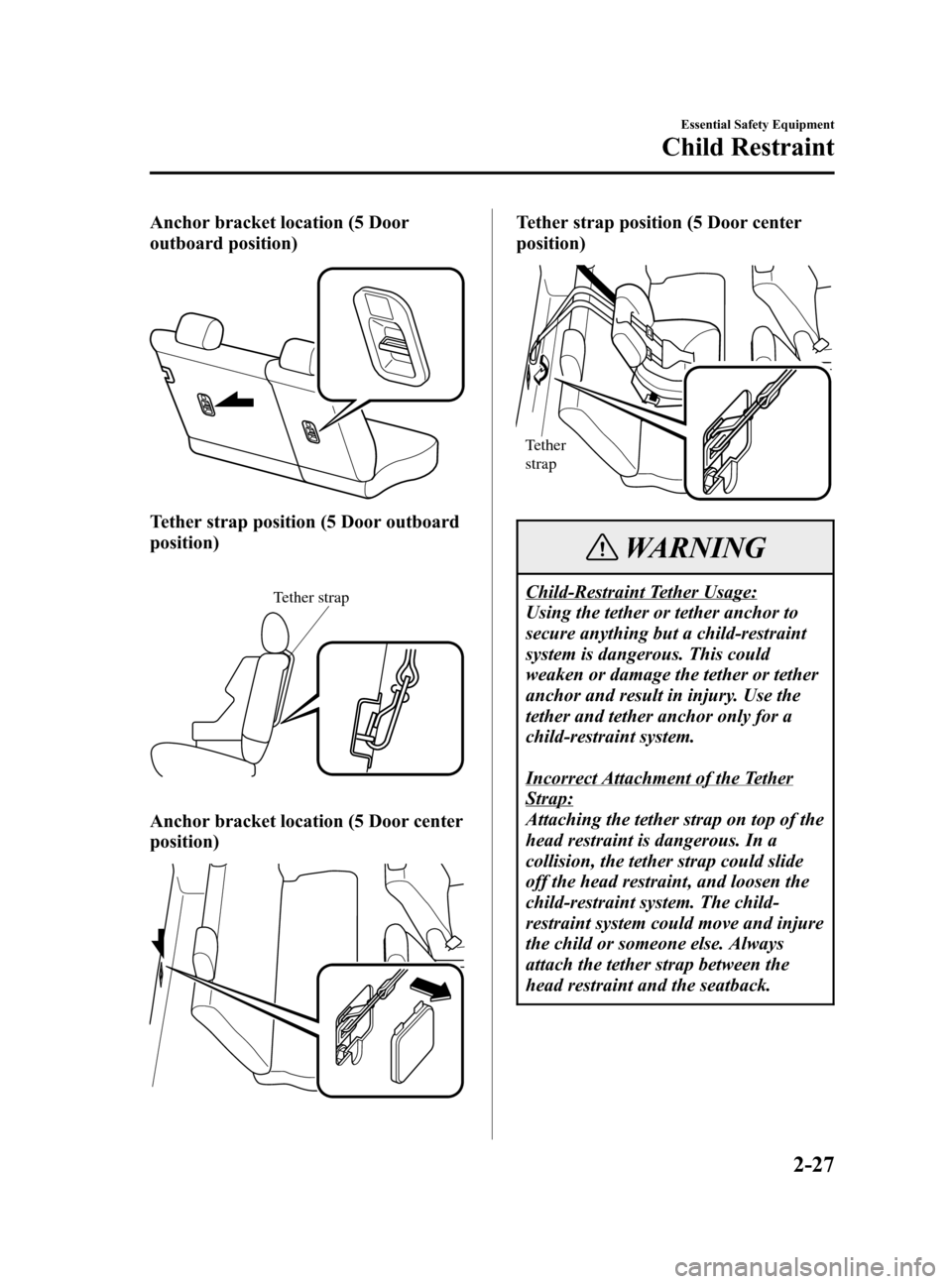
Black plate (41,1)
Anchor bracket location (5 Door
outboard position)
Tether strap position (5 Door outboard
position)
Tether strap
Anchor bracket location (5 Door center
position)
Tether strap position (5 Door center
position)
Tether
strap
WARNING
Child-Restraint Tether Usage:
Using the tether or tether anchor to
secure anything but a child-restraint
system is dangerous. This could
weaken or damage the tether or tether
anchor and result in injury. Use the
tether and tether anchor only for a
child-restraint system.
Incorrect Attachment of the Tether
Strap:
Attaching the tether strap on top of the
head restraint is dangerous. In a
collision, the tether strap could slide
off the head restraint, and loosen the
child-restraint system. The child-
restraint system could move and injure
the child or someone else. Always
attach the tether strap between the
head restraint and the seatback.
Essential Safety Equipment
Child Restraint
2-27
Mazda3_8T97-EC-04J_Edition1 Page41
Saturday, September 25 2004 2:7 PM
Form No.8T97-EC-04J